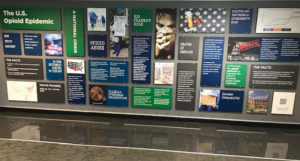US opioid crisis sparks campus, community conversations
April 26, 2019 • Uncategorized

Every day, more than 130 Americans die and more than 1,000 people are treated in U.S. hospital emergency departments for misuse of opioids like heroin, fentanyl, Oxycontin and other prescription pain relievers.
“Arguably, the opioid epidemic is our country’s foremost public health challenge,” said Dr. Dennis Thombs, Dean of the UNTHSC College of Public Health, and the driving force behind a new, educational public exhibit space on campus dedicated to this widespread national health problem.
“More than 11.4 million Americans misused prescription opioids in 2017, accounting for 67% of U.S. drug overdose deaths,” he said. “This is truly a national emergency of epic proportions.”
Dr. Thombs was inspired to create a learning space within the CPH where the campus and community could gather information about this problem and its causes.
“There are many reasons for the current opioid epidemic,” Dr. Thombs said. “The impact of illegal overseas drug production entering the U.S. tells just one side of the story. As shown through court cases and investigations, major pharmaceutical companies, or ‘Big Pharma,’ also share in the blame.”
In recent breaking news, former executives from one of the country’s top 10 largest pharmaceutical distributors made headlines when they were charged with criminal conspiracy to defraud the U.S., violation of narcotics laws and willful failure to report suspicious drug orders, in what is being called the first landmark legal action in the fight against the opioid crisis.
Currently, 41 state attorneys general have filed lawsuits against opioid producers for their role in the crisis.
More details on Big Pharma’s influences on the medical industry, politics, government and an unwitting general public are shared in the CPH exhibit.
A portion of the exhibit is also dedicated to what has been called “deaths of despair,” focused on another critical impetus behind the opioid epidemic.
In a 1999-2014 national study, research found that for each 1% rise in county unemployment rates, there was a 7% jump in opioid overdose emergencies and a 3.6% increase in opioid deaths.
“Studies have found that economically dislocated workers impacted by the stress of recession and loss of jobs are more vulnerable and apt to cope with their emotional distress through risky behaviors and use of drugs like opioids,” Dr. Thombs said.
In addition to other key aspects of the current opioid crisis, the CPH exhibit highlights different states where the problem is especially prevalent.
“Texas has had lower rates of overdose and deaths than many other states so far,” Dr. Thombs said. “Advisories warn, though, that it may only be a matter of time before the epidemic reaches our own local communities and threatens the lives of people here in Texas.”
The self-guided exhibit can be viewed at any time in the CPH student lounge, seventh floor of the Carl E. Everett Education and Administration (EAD) building. Access to all research sources and background information is provided.
Concerned about a friend or someone close to you? For information on Naloxone, the emergency opioid overdose antidote available to the public without questions or a prescription, learn more here.


Social media